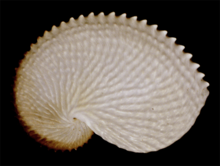| Knobby Argonaut | |
|---|---|

| |
| Eggcase of Argonauta nodosus | |
| Scientific classification | |
| Domain: | Eukaryota |
| Kingdom: | Animalia |
| Phylum: | Mollusca |
| Class: | Cephalopoda |
| Order: | Octopoda |
| Family: | Argonautidae |
| Genus: | Argonauta |
| Species: | A. nodosus
|
| Binomial name | |
| Argonauta nodosus Lightfoot, 1786
| |
| Synonyms | |
Argonauta nodosus [previously known as Argonauta nodosa[3][4][5]], also known as the knobby or knobbed argonaut, is a species of pelagic octopus. The female of the species, like all argonauts, creates a paper-thin eggcase that coils around the octopus much like the way a nautilus lives in its shell (hence the name paper nautilus). The shell is usually approximately 150 mm in length, although it can exceed 250 mm in exceptional specimens; the world record size is 292.0 mm.[6] A. nodosus produces a very characteristic shell, which is covered in many small nodules on the ridges across the shell, hence the specific epithet nodosus and common name. These nodules are less obvious or even absent in juvenile females, especially those under 5 cm in length.[7] All other argonaut species have smooth ridges across the shell walls.[7]
- ^ Allcock, L. (2014). "Argonauta nodosa". The IUCN Red List of Threatened Species. 2014: e.T163029A965050. doi:10.2305/IUCN.UK.2014-3.RLTS.T163029A965050.en. Downloaded on 05 February 2018.
- ^ Kirk, T.W. ('1884'). Art. VII.—Description of a new species of paper nautilus (Argonauta gracilis). Transactions and Proceedings of the New Zealand Institute 17: 58–59. (reprint)
- ^ Finn, Julian K. (2013). "Taxonomy and biology of the argonauts (Cephalopoda: Argonautidae) with particular reference to Australian material". Molluscan Research. 33 (3): 143–222. doi:10.1080/13235818.2013.824854. S2CID 84533043.
- ^ "Mollusca Base website". Mollusca Base website. Archived from the original on 2021-08-23.
- ^ "WoRMS website". WoRMS website. Archived from the original on 2021-08-23.
- ^ Pisor, D. L. (2005). Registry of World Record Size Shells (4th ed.). Snail's Pace Productions and ConchBooks. p. 12.
- ^ a b Norman, M. (2000). Cephalopods: A World Guide. ConchBooks. p. 192.
